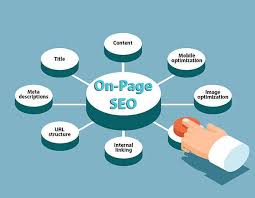SEO On-Page Optimization: A Comprehensive Guide
Search Engine Optimization (SEO) is crucial for improving your website’s visibility and ranking on search engine results pages. One essential aspect of SEO is on-page optimization, which focuses on optimizing individual web pages to enhance their relevance and authority for specific keywords.
Key Elements of On-Page Optimization:
- Title Tags: The title tag is one of the most critical on-page SEO elements. It should be concise, descriptive, and contain relevant keywords.
- Meta Descriptions: Meta descriptions provide a brief summary of the webpage’s content. They should be compelling, informative, and include targeted keywords.
- Heading Tags: Proper use of heading tags (H1 to H6) helps structure your content and improve readability. Include relevant keywords in your headings to signal the page’s main topics.
- URL Structure: Create user-friendly URLs that are descriptive and contain keywords. Avoid using complex or lengthy URLs that can confuse both users and search engines.
- Keyword Optimization: Strategically place relevant keywords throughout your content, including in headings, paragraphs, image alt text, and meta tags.
- Quality Content: High-quality, valuable content is essential for engaging users and earning backlinks. Ensure your content is well-written, informative, and addresses the needs of your target audience.
- Image Optimization: Optimize images by using descriptive filenames, alt text with relevant keywords, and appropriate file sizes to improve page load speed.
Tips for Effective On-Page Optimization:
- Create Unique Content: Avoid duplicate content issues by crafting original and valuable content that sets you apart from competitors.
- Optimize Page Load Speed: Improve user experience by optimizing images, reducing server response time, and leveraging browser caching to enhance page load speed.
- Mobile-Friendly Design: Ensure your website is responsive and mobile-friendly to cater to users accessing your site on smartphones and tablets.
- User Experience (UX): Enhance user experience by organizing content logically, using clear navigation menus, and optimizing for readability.
- Social Sharing Integration: Encourage social sharing by including social media buttons on your pages to increase visibility and engagement.
In conclusion, on-page optimization plays a crucial role in improving your website’s search engine ranking and attracting organic traffic. By implementing these best practices and staying updated with SEO trends, you can enhance the visibility of your web pages and drive meaningful results for your online presence.
7 Essential Tips for Effective On-Page SEO Optimization
- Perform keyword research to identify relevant and high-traffic keywords for your content.
- Optimize your titles, meta descriptions, and headers with targeted keywords.
- Create high-quality and engaging content that is valuable to your audience.
- Optimize your images with descriptive file names and alt text for better visibility in search results.
- Improve your website’s loading speed for better user experience and search engine rankings.
- Use internal linking to connect related content within your website for better navigation and SEO benefits.
- Regularly monitor and analyze your on-page SEO performance using tools like Google Analytics and Search Console.
Perform keyword research to identify relevant and high-traffic keywords for your content.
Performing keyword research is a fundamental step in on-page optimization for SEO. By identifying relevant and high-traffic keywords for your content, you can effectively target your audience and improve your website’s visibility on search engine results pages. Understanding the search terms that users are using allows you to create content that aligns with their interests and needs, ultimately driving organic traffic to your site. Comprehensive keyword research empowers you to optimize your web pages strategically, increasing the likelihood of ranking higher in search results and reaching a wider audience.
Optimize your titles, meta descriptions, and headers with targeted keywords.
Optimizing your titles, meta descriptions, and headers with targeted keywords is a fundamental aspect of on-page SEO optimization. By strategically incorporating relevant keywords into these elements, you can enhance the visibility and relevance of your web pages to search engines. Titles serve as the first impression for users in search results, while meta descriptions offer a concise summary of the page’s content. Additionally, headers help structure your content and signal its main topics to both users and search engines. By focusing on keyword optimization in these key areas, you can improve your website’s ranking potential and attract more organic traffic effectively.
Create high-quality and engaging content that is valuable to your audience.
Creating high-quality and engaging content that provides value to your audience is a cornerstone of effective on-page optimization for SEO. By offering informative, relevant, and well-crafted content, you not only attract and retain visitors but also signal to search engines that your website is a valuable resource. Engaging content that addresses the needs and interests of your target audience can lead to increased user engagement, longer time spent on your site, and ultimately improved search engine rankings. Prioritizing quality content creation is key to building credibility, authority, and visibility in the competitive online landscape.
Optimize your images with descriptive file names and alt text for better visibility in search results.
Optimizing images with descriptive file names and alt text is a key strategy in on-page SEO optimization. By providing relevant keywords in both the file names and alt text of your images, you enhance their visibility in search results and improve the overall relevance of your web pages. Search engines rely on this information to understand the content of your images, making it easier for them to index and display your visual content to users searching for related topics. Implementing this practice can significantly boost your website’s SEO performance and attract more organic traffic to your site.
Improve your website’s loading speed for better user experience and search engine rankings.
Improving your website’s loading speed is a crucial aspect of on-page optimization that can significantly impact both user experience and search engine rankings. A fast-loading website not only enhances user satisfaction by providing a seamless browsing experience but also signals to search engines that your site is well-optimized and user-friendly. By optimizing images, reducing server response time, and leveraging browser caching, you can enhance your website’s loading speed, leading to improved visibility in search results and higher engagement from visitors. Prioritizing loading speed optimization is key to ensuring that users have a positive interaction with your site while also boosting your SEO efforts for better online performance.
Use internal linking to connect related content within your website for better navigation and SEO benefits.
Utilizing internal linking is a powerful strategy in SEO on-page optimization that not only enhances the navigation experience for users but also provides significant SEO benefits. By connecting related content within your website through internal links, you create a network of interconnected pages that search engines can crawl and index effectively. This not only helps search engines understand the structure and relevance of your content but also distributes link equity throughout your site, boosting the authority of individual pages. Implementing strategic internal linking can improve user engagement, reduce bounce rates, and ultimately contribute to higher search engine rankings for your website.
Regularly monitor and analyze your on-page SEO performance using tools like Google Analytics and Search Console.
Regularly monitoring and analyzing your on-page SEO performance using tools like Google Analytics and Search Console is crucial for optimizing your website’s visibility and effectiveness. These tools provide valuable insights into how users interact with your site, which keywords drive traffic, and areas for improvement. By staying informed about your on-page SEO metrics, you can make data-driven decisions to enhance your content, keywords, and overall user experience, ultimately boosting your search engine rankings and attracting more organic traffic to your website.





